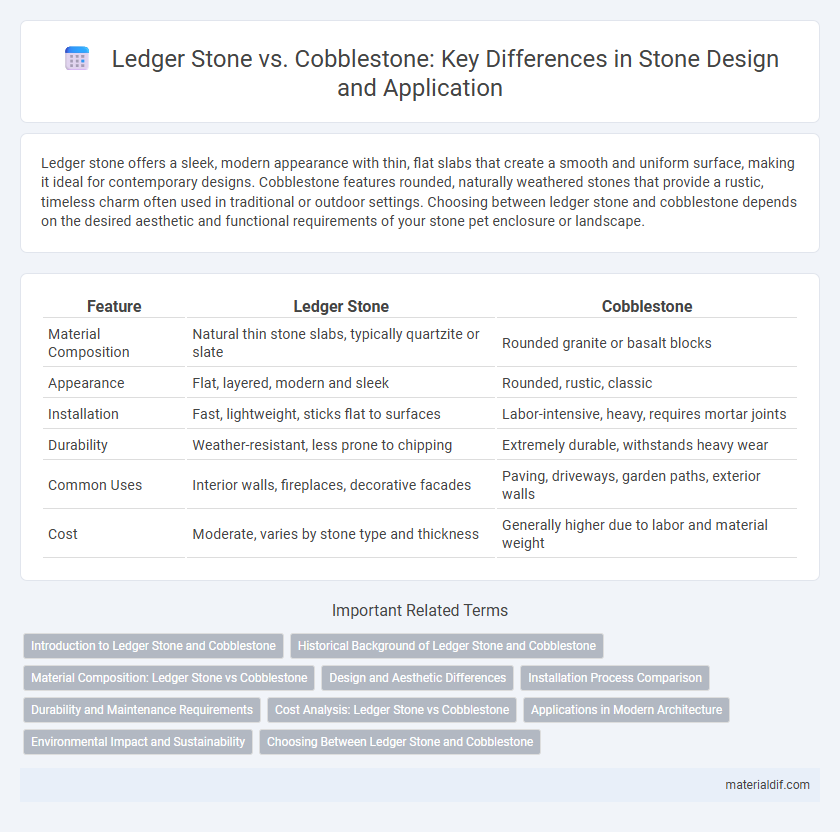Ledger stone offers a sleek, modern appearance with thin, flat slabs that create a smooth and uniform surface, making it ideal for contemporary designs. Cobblestone features rounded, naturally weathered stones that provide a rustic, timeless charm often used in traditional or outdoor settings. Choosing between ledger stone and cobblestone depends on the desired aesthetic and functional requirements of your stone pet enclosure or landscape.
Table of Comparison
| Feature | Ledger Stone | Cobblestone |
|---|---|---|
| Material Composition | Natural thin stone slabs, typically quartzite or slate | Rounded granite or basalt blocks |
| Appearance | Flat, layered, modern and sleek | Rounded, rustic, classic |
| Installation | Fast, lightweight, sticks flat to surfaces | Labor-intensive, heavy, requires mortar joints |
| Durability | Weather-resistant, less prone to chipping | Extremely durable, withstands heavy wear |
| Common Uses | Interior walls, fireplaces, decorative facades | Paving, driveways, garden paths, exterior walls |
| Cost | Moderate, varies by stone type and thickness | Generally higher due to labor and material weight |
Introduction to Ledger Stone and Cobblestone
Ledger stone features thin, flat pieces of natural stone arranged in a stacked pattern, creating a sleek, contemporary appearance ideal for accent walls and fireplaces. Cobblestone consists of rounded, irregularly shaped stones typically used in paving, offering a rustic, old-world charm with natural texture and durability. Both materials showcase unique stone characteristics but serve different design functions, with ledger stone emphasizing vertical surfaces and cobblestone designed for ground applications.
Historical Background of Ledger Stone and Cobblestone
Ledger stone, historically used in medieval Europe, served as inscribed grave markers laid flat over tombs, often made from thick slabs of sandstone or limestone that preserved detailed epitaphs. Cobblestone, dating back to ancient Roman roads, consists of naturally rounded stones set in sand or mortar, originally employed to create durable, weather-resistant surfaces for streets and pathways. Both materials reflect significant regional craftsmanship, with ledger stones emphasizing funerary artistry and cobblestones showcasing early infrastructure engineering.
Material Composition: Ledger Stone vs Cobblestone
Ledger stone is primarily composed of natural sedimentary rock such as slate, quartzite, or quartz-based stone, characterized by its thin, flat layers ideal for cladding and decorative facades. Cobblestone consists mainly of rounded igneous or metamorphic stones like granite, basalt, or river rock, valued for its durability and irregular shape used in paving and landscaping. The difference in material composition influences their texture, application, and structural benefits in construction and exterior design.
Design and Aesthetic Differences
Ledger stone features thin, flat slabs arranged in a linear, stacked pattern, creating a sleek and modern facade with a smooth, uniform texture that highlights natural stone tones. Cobblestone consists of rounded, irregularly shaped stones set in a mosaic-like pattern, giving a rustic, old-world charm with a textured, three-dimensional surface that varies in color and size. The distinct design approaches impact visual appeal: ledger stone offers a contemporary, streamlined look, while cobblestone provides a timeless, rugged aesthetic ideal for traditional settings.
Installation Process Comparison
Ledger stone installation involves adhering thin, flat stone veneers directly onto clean, flat surfaces using specialized adhesives, minimizing the need for mortar or extensive groundwork. Cobblestone installation requires laying individual rounded stones over a prepared base with sand and mortar, ensuring proper alignment and spacing to create a stable, durable surface. The ledger stone process is typically faster and less labor-intensive, while cobblestone demands more time and skill due to its three-dimensional, irregular stone shapes.
Durability and Maintenance Requirements
Ledger stone offers high durability due to its dense, natural composition, making it resistant to chips and cracks over time, whereas cobblestone may show more wear under heavy foot traffic due to its rounded edges and variable hardness. Maintenance for ledger stone typically involves minimal sealing and occasional cleaning to retain its appearance, while cobblestone requires more frequent sealing and joint upkeep to prevent weed growth and shifting stones. The long-term investment in ledger stone can result in lower maintenance costs compared to cobblestone's ongoing repair and cleaning needs.
Cost Analysis: Ledger Stone vs Cobblestone
Ledger stone typically costs between $15 and $30 per square foot, making it a moderately priced option for wall cladding with a natural, textured appearance. Cobblestone generally ranges from $20 to $50 per square foot due to its thicker, rounded shape and installation complexity requiring more labor hours and specialized tools. Cost analysis favors ledger stone for budget-conscious projects, while cobblestone offers a durable, rustic aesthetic with higher upfront investment and maintenance expenses.
Applications in Modern Architecture
Ledger stone offers sleek, uniform surfaces ideal for contemporary walls, flooring, and exterior cladding, enhancing modern architectural aesthetics with clean lines and minimal grout gaps. Cobblestone, with its irregular shapes and textured surface, is favored in landscaping, pathways, and rustic building facades, providing a timeless, organic look that contrasts with smooth, modern finishes. Both materials lend durability and natural beauty, but ledger stone's precise cuts suit urban designs, while cobblestone supports traditional and vernacular architecture applications.
Environmental Impact and Sustainability
Ledger stone offers a more sustainable building option compared to cobblestone due to its efficient extraction process and lower transportation emissions, as the thin, flat slabs require less material and energy to quarry and transport. Cobblestone, often sourced in larger, irregular shapes, demands more intensive mining and shaping processes that contribute to higher environmental degradation and energy use. The durability and low maintenance of ledger stone further reduce its carbon footprint over time, enhancing its eco-friendly profile in sustainable construction.
Choosing Between Ledger Stone and Cobblestone
Ledger stone offers a sleek, linear aesthetic ideal for modern architectural designs, providing a smooth surface that fits tightly together, enhancing durability and ease of installation. Cobblestone features a more rustic, rounded appearance, commonly used in pathways and driveways for its natural texture and slip resistance. When choosing between ledger stone and cobblestone, consider the desired visual style, application area, and maintenance requirements to achieve the best functional and aesthetic results.
Ledger Stone vs Cobblestone Infographic

 materialdif.com
materialdif.com